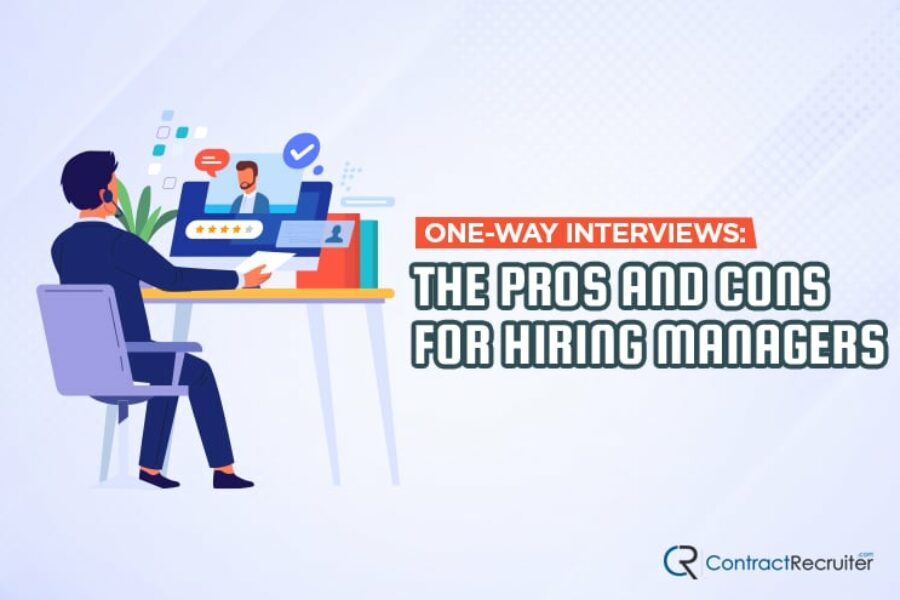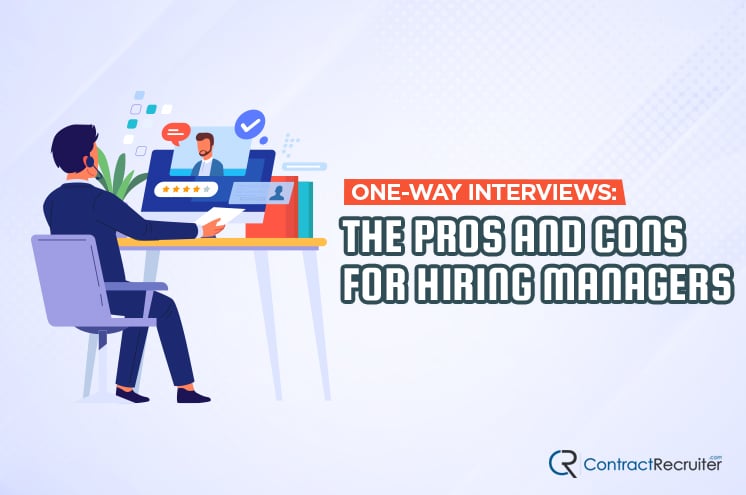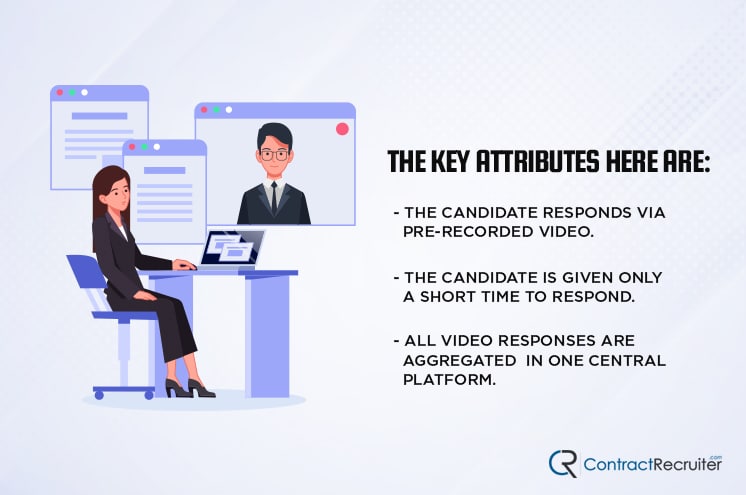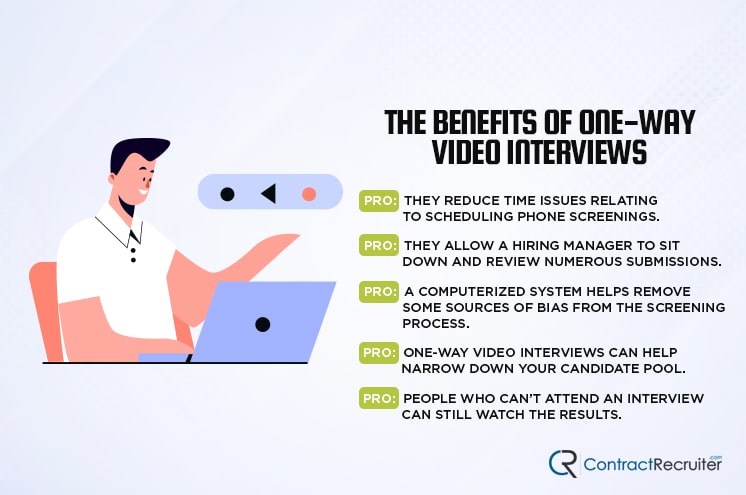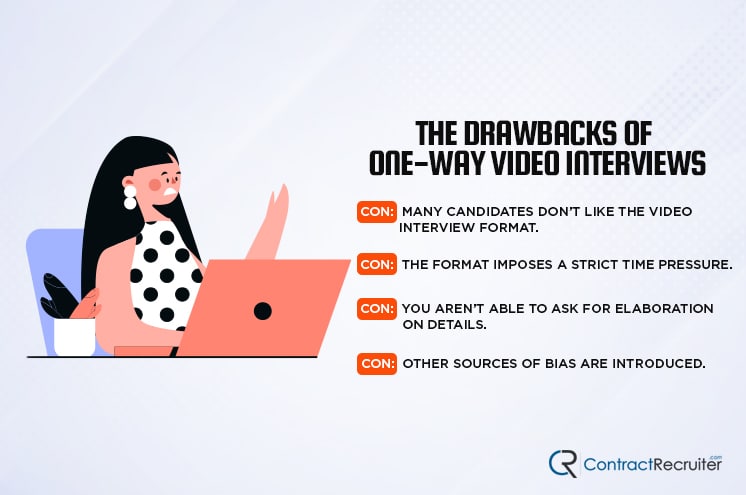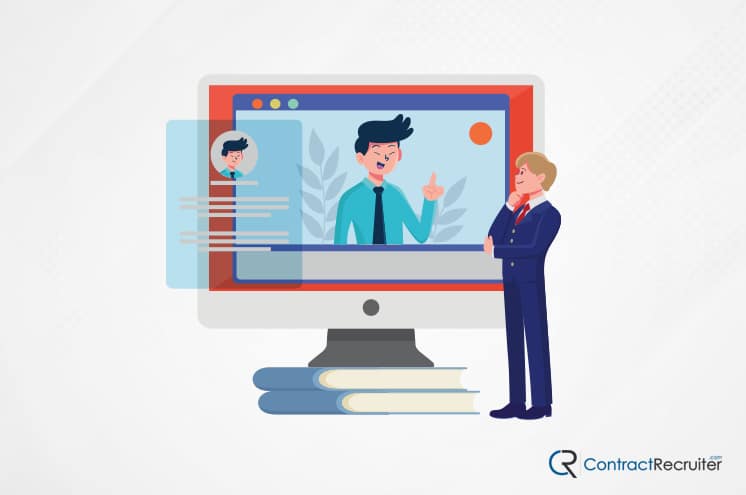There are many ways to go about hiring someone for an open position. One such option is the one-way video interview. It’s a technique that has risen in popularity over the years but may be on the decline. Is it worth using? What are the pros and cons? Read on to find out.
What is a One-Way Video Interview?
A one-way video interview is conducted via a pre-recorded video, done asynchronously.
The general process looks like this:
- Your company posts a job posting on career portals and waits for applications.
- You filter through applications to select promising candidates, either manually or via an applicant tracking system with filters.
- You reach out to a pool of candidates and ask them to submit a video interview. Typically, this involves a link to a web portal that will aggregate these video interviews.
- The candidate logs into the portal, where they are given a series of screening questions relevant to the role.
- The candidate records a video (or a series of short videos, depending on the format) in response to the questions and uploads those videos to the web portal.
- Your HR representative and hiring manager review these videos and use them to select the smaller pool of candidates to proceed to more traditional interviews.
- Eventually, you pick someone and hire them to fill the open role.
The key attributes here are:
- The candidate responds via pre-recorded video. There is no two-way communication, just a question, and an answer. They do not have the opportunity to discuss the question with you, and you do not have the chance to ask for clarification in their response, at least not immediately.
- The candidate is given only a short time to respond. Typically, a question appears, and the candidate is provided around a minute to read it and think of an answer before the platform begins recording.
- All video responses are aggregated in one central platform, in a consistent format recorded by the platform, so your HR managers can review them at any time, without needing to deal with scheduling to meet with the candidate for a traditional interview.
One-way interviews are typically used as early screeners. Later discussions and second or third interviews tend to deal with more detailed, personalized, or nuanced conversations, which require an actual discussion. Most people recommend one-way video interviews as a replacement to a traditional phone screening, not the later face-to-face interview process.
What Are the Benefits of One-Way Video Interviews?
The one-way video interview process has several significant benefits for companies.
Pro: They reduce time issues relating to scheduling phone screenings.
One of the most prominent issues with the hiring process is the time it takes to handle scheduling. Your hiring staff only have so much availability, and if they need to block out large portions of their day to handle phone screening calls, a lot of time ends up wasted. Moreover, you have to find times that work for both your hiring manager and your candidate, and if the candidate has to cancel or reschedule at the last minute, it can throw an entire schedule into disarray.
With a one-way video interview, your candidates can record and submit their responses anytime they are available, including late at night, early in the morning, or on a weekend when your HR staff is out of the office. Likewise, your HR staff can review the submissions whenever they have the time to do so and are not beholden to a specific schedule.
Pro: They allow a hiring manager to sit down and review numerous submissions at the same time.
Another advantage of a one-way video interview is the time limitations on candidate answers, small talk, and assorted distractions. All of the responses will be around the same length, which, typically, will be shorter than asking and answering the same question in a synchronous screening process. Your HR team can spend a lot less time reviewing submissions and more directly compare answers from different candidates in the same time span.
Pro: A computerized system helps remove some sources of bias from the screening process.
There are many possible sources of bias in hiring. Some are very subtle. The way you ask a question – even a simple screening question – can influence the answer, the way the answer is conveyed, and even how you listen to it. A hiring manager progressing through multiple phone screens might be biased towards a candidate and be more dismissive of another on the phone, especially after a long day of screening.
With a video interview, all of the questions are asked by a computer in the same way to every candidate. The time limits are the same, and the flexibility is the same; every candidate is given the same starting point to answer their questions. That removes one source of interviewer bias from the equation entirely.
Above, we mentioned that a one-way interview lacks the opportunity to ask for clarification or greater detail. This lack of opportunity is both bad and good, as it can remove distractions and unnecessary information from the process.
Pro: As a screening process, one-way video interviews can help narrow down your candidate pool before investing in more time-consuming ways to screen them.
As a screening process, a one-way video interview can help reduce your candidate pool more quickly than the lengthier phone screens will. There’s an inherent desire to give anyone who makes it through an application process at least some chance, but, with a video interview, poor-quality candidates may reveal themselves in a way that gives them less option to refute issues and removes them from the running more quickly, saving everyone time.
Pro: The videos are not deleted; people who can’t attend an interview can still watch the results.
In many cases, you will want to get several sets of eyes on any given candidate. However, scheduling multiple people’s availability for an interview is significantly more challenging than a one-on-one meeting.
With a video interview, everyone on your hiring panel can view it at their leisure and make their judgments or discuss it with one another later on. You don’t need everyone involved in the hiring decision to be available simultaneously to go over the results.
What Are the Drawbacks of One-Way Video Interviews?
While one-way video interviews can save a company time and money, they also have several cons. It’s up to you whether or not these outweigh the pros for your company.
Con: Many candidates don’t like the video interview format.
While video interviews are not uncommon, they’re also not incredibly popular. Per FlexJobs:
“When given the choice between live, two-way video interviews and one-way video interviews, 57% of respondents indicated they would rather participate in a two-way video interview, specifically stating that the live interviews allow them to see body language and other visual cues that help them “read the room” during an interview.”
Some candidates find one-way interviews to be dehumanizing. Others find it to be a massive effort for such an early part of the interview process, which increases their burden when there’s little guarantee that they’ll be hired for the role.
Some of the best candidates will refuse to perform in a one-way video screening. They might be an excellent choice for your role, but they would rather apply to a company that doesn’t ask them to do a video screening instead.
Con: The format imposes a strict time pressure.
Since the candidate only has a limited amount of time to read and respond to a question, they don’t have much opportunity to correct mistakes, and the time pressure adds stress to the situation. Some more camera-shy candidates might not be able to put their best foot forward when they would be more capable in a phone interview.
Con: You aren’t able to ask for elaboration on details.
Part of the reason why synchronous interview techniques are used is the ability to build a dialogue and rapport with a candidate. If they mention something you want to know more about, you can ask them. If they do so in a one-way interview, you have to wait until further interviews to ask, and if they don’t otherwise make it that far, you won’t find out.
The reverse is also true. If a question is phrased awkwardly and a candidate doesn’t quite understand it, they can ask for clarification on a two-way interview, but they are left to flounder in a one-way interview.
Screenings and early interviews are about the candidate interviewing you as much as they are about you interviewing the candidate. They want to know if you’re going to be a good fit for them. They don’t get to find out in a one-way interview; if you progress far enough into the hiring process to have the discussion, you will have invested significantly in a candidate who still hasn’t decided if they will continue the process with you.
Con: Other sources of bias are introduced.
While some sources of bias are removed, as mentioned above, others are introduced.
For example: does your candidate have easy access to an appropriate setting to record their video? Do they have an operative video camera? Sure, these are built into laptops, but not everyone has one. A phone might not be the appropriate device. Some individuals might be applying from a public library or another location not as suitable for such an interview.
Others might not be tech-savvy. A video issue can occur that the candidate might not know how to fix. They could be an excellent candidate for certain non-tech roles, but you will never know.
Video interviews are suppressive of entire groups of candidates, and that’s a kind of bias you cannot ignore.
You also may be more influenced by the quality of the video than you should be. Two identical candidates could record similar answers, and you’d be more likely to focus on the one with a professional-grade camera, mic, and lighting setup over the one using their phone in a bedroom while a child makes noise in another room.
Lilly Obina, a senior project leader, described a stressful and time-consuming process:
“You have to find a quiet room, look for lights, especially for dark-skinned folks like me. You need a great device to tape, so it produces good quality video, which was very expensive for me considering every penny counts when you have no job. Answering the questions are very stressful because you have to think of your answer, think of the short time you have and when recording around other people who are helping out to hold camera and lighting, you end up somehow disorganized.”” – Toister Solutions.
Some of these issues can also tie into racial biases. For example, darker-skinned candidates need to spend more time on lighting to make themselves visible on a camera, which can lead to racial bias in your screening, even if it’s inadvertent.
Should You Use One-Way Video Interviews for Your Company?
One-way video interviews are not likely to disappear entirely. However, they may be on their way out due to the increasing prevalence of video conferencing options and tools like Zoom.
The question is, should your company invest in one-way interviews?
The drawbacks can be significant. Suppressing top-tier candidates, especially those in minority groups or who aren’t tech-savvy enough, can be highly detrimental to your hiring. It can even, in extreme cases, lead to discrimination accusations.
On the other hand, the benefits to time, scheduling, and volume can be extreme. As an early part of screening, a well-designed, well-used video interview process can save a company a nearly unbelievable amount of time and money.
We can’t answer for you. It all comes down to your specific situation. Some companies will benefit from one-way interviews; others will find them too detrimental to their candidate pool. Just be aware of the pros and cons, and make an informed decision.
Do you or your company have any questions or concerns about one-way video interviews? Is there anything you would like a little clarification on? If so, please feel free to leave a comment down below, and we’ll get a conversation started! We would be more than happy to answer any of your potential questions and clear up any causes for concern.

